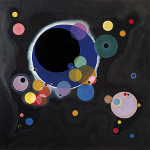Orienting in space requires active visual exploration and the processing of environmental cues. Visual spatial cues can either be geometric, such as the global shape of the environment, or correspond to local landmarks, such as objects independent of the environment's layout. Although the brain structures implicated in spatial coding are well characterized, the neural networks involved in geometry vs. landmark visual cue reliance remain elusive. To address this issue, this study used functional magnetic resonance imaging to differentiate the brain activities that are specifically associated with landmark- and geometry-based navigation. Twenty-five young participants explored a Y-maze and had to learn the location of a hidden goal. Subjects then had to navigate to the goal from different starting positions throughout the maze in two separate conditions: a landmark condition, in which reorientation required the processing of three differently-shaped objects; and a geometry condition, in which reorientation required the processing of the environment's shape. Participants performed similarly in both conditions in terms of escape latency and rate of correct responses. At the cortical level, two distinct cerebral networks were observed. Reorienting based on landmark information was associated with a greater occipital, hippocampal and cerebellar involvement as well as with a specific activation of the perirhinal cortex. In contrast, reliance on the geometric shape of the environment elicited a specific activity in the anterior cingulate and frontal cortices. ROI analyses revealed that the dorsal striatal structures were activated in the geometric condition only, whereas the hippocampus had similar activations in the two conditions. The pattern of activity associated with landmark-based reorientation is congruent with the processing of fine-grained spatial information, while the increased frontal and cingulate activities in geometry-based reorientation reflect the task's greater cognitive control requirements. Moreover, in the geometry condition, the co-activation of hippocampal and striatal regions seems to indicate a flexible use of several navigational strategies mediated by frontal regions.
By speaker > Durteste Marion
Distinct cerebral structures are involved in landmark- vs. geometry-based spatial navigation
1 : Sorbonne Universités, UPMC Univ Paris 06, INSERM, CNRS, Institut de la Vision, 17 rue Moreau, F-75012 Paris
Sorbonne Universités, UPMC Univ Paris 06, INSERM, CNRS, Institut de la Vision, 17 rue Moreau, F-75012 Paris
2 : CHNO des Quinze-Vingts, DHU Sight Restore, INSERM-DHOS CIC, 28 rue de Charenton, 75012 Paris, France
* : Corresponding author
Institut National de la Santé et de la Recherche Médicale : CIC503
Chno Des Quinze-Vingts PARIS VI 28, Rue de Charenton 75012 PARIS -
France
| Online user: 51 | RSS Feed |

|

 PDF version
PDF version